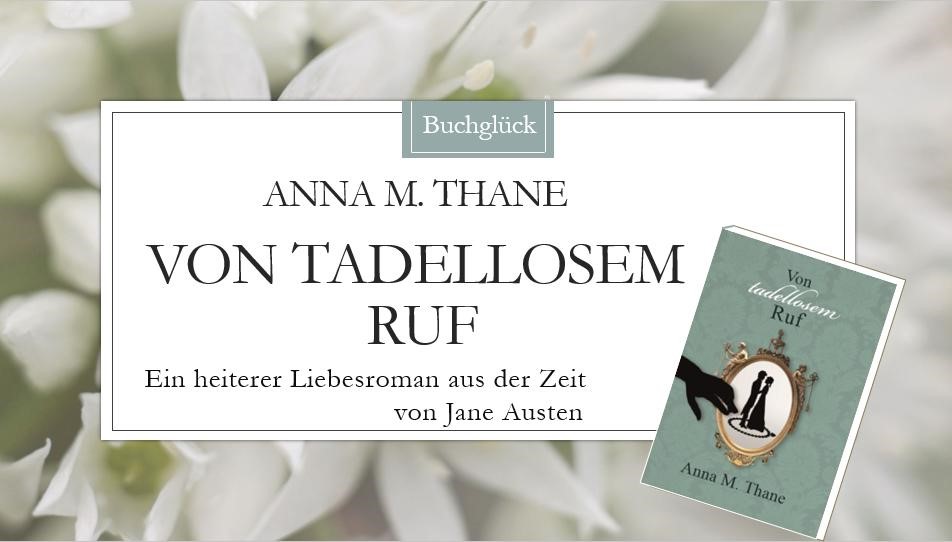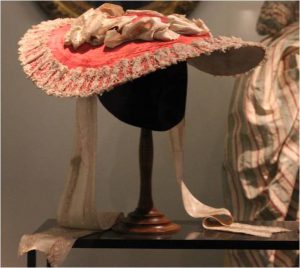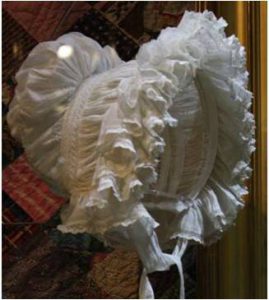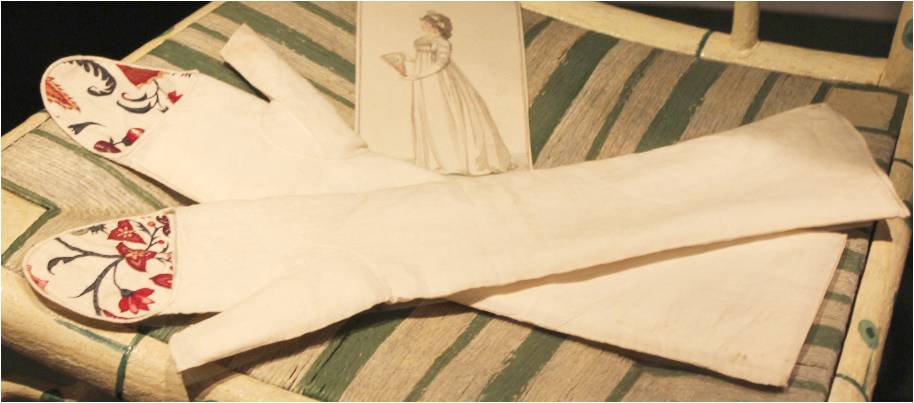 Female fashion of the 18th century featured a fabulous wealth of accessories. This post looks at shoes, gloves, hats, fichus, jewellery and many other beautiful fashion items from about 1750 to 1825. Follow me to the world of accessories for ladies.
Female fashion of the 18th century featured a fabulous wealth of accessories. This post looks at shoes, gloves, hats, fichus, jewellery and many other beautiful fashion items from about 1750 to 1825. Follow me to the world of accessories for ladies.
Hats and bonnets
Throughout most of the 18th century, the ‘shepherdess’ hat was popular. It was worn to keep the sun off the face. A fair complexion was considered ladylike, whereas a suntanned skin marked the lower classes that worked outside.
Hats fell out-off fashion after the French Revolution. They were associated with the aristocracy. Instead, simpler forms, e.g. a bonnet, made of less expensive fabrics such as cotton and straw were regarded as desirable ‘democratic’ fashion items.
From the 1790ies and Nelson‘s victory in Egypt, England fell in love with the Eastern World. The turban was introduced as a fashionable headpiece for High Society ladies.
After the battle of Waterloo, hats had their comeback. Their design was often inspired by military shapes and adornments. In the 1820ies hats were richly decorated with feather plumes and silk bows.
Did you know?
As Napoleon’s Continental System was blocking England from many of its former trade partners, it became difficult for the English to buy quality straw bonnets from Italy. Bonnets made from inexpensive bonnet board and silk-covered buckram became a substitute for straw.
Caps
A variety of caps was available for women and young girls. The most fashionable were the ‘mobcap’ and a round-eared cap. Both were adorned with lace and featured two long fabric streamers (so called lappets). The mobcap covered the head, but not the ears. The round-eared cap allowed a lady to cover the ears and hide a bad hair day.
Did you know?
There were 3 ways to handle the long fabric streamers: You could tie them under the chin, have them hang down the back or pin them on top of the cap.
The fichu
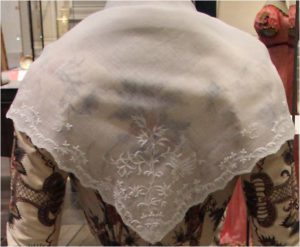 The fichu was a triangular or square piece of cloth made of fine cotton, linen, wool, or embroidered lace. It was worn to cover a ladies neckline.
The fichu was a triangular or square piece of cloth made of fine cotton, linen, wool, or embroidered lace. It was worn to cover a ladies neckline.
Did you know?
A covered neckline was considered a display of high morality and virtue. When it was fashionable to wear low-cut dresses or even dresses that uncovered the breast, a fichu made sure that decency was maintained.
Mittens and gloves
Gloves were more than a fashion item: They were indispensible. To be seen outside, at a ball or at the theatre without gloves would be a clear indication of poor breeding. Why? In an age when a handshake between a man and a woman was considered intimate, wearing gloves protected a lady from directly touching male skin. Similarly, a gentleman should never touch a lady without his gloves on.
Mittens kept fingers warm in the cold and in summer month also protected them from the sun. They were worn outside as well as inside. Usually, mittens had a thumb but no other fingers. However, the fabric extended over part of the fingers. This allowed a lady to write, draw or do needlework while wearing mittens.
Did you know?
Gloves and mittens for formal and semi-formal wear came in three lengths: wrist length, elbow length, and arm length. Short mittens would e.g. be worn for a morning visit, while the longer ones were for more formal occasions.
Reticule
 The reticule is a unique invention of the Regency period. It was the first small handbag for ladies, designed to carry necessities. The reticule was made of lightweight fabric or net, and it was closed with drawstrings.
The reticule is a unique invention of the Regency period. It was the first small handbag for ladies, designed to carry necessities. The reticule was made of lightweight fabric or net, and it was closed with drawstrings.
Did you know?
The reticule was invented when the fashion of gowns changed from the heavy, multi-layered dresses of the Baroque Age to light and transparent gowns in the style of a Roman or Grecian toga. The multi-layered dresses were made of thick fabric and had allowed women to wear pockets girded around the hip under the skirts or to have pockets sewn into the skirt. The silhouette of the new gowns was so slim that pockets in or under the dress would have ruined the look.
Shawls
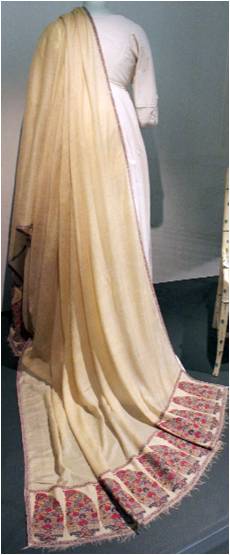 The shawl rose to fashion from around 1780 when the first beautifully embroidered and printed pieces were imported from Kashmir. European producers soon picked up the trend. The shape of the shawl changed to suit the dresses with which it was worn. A simple long light stole was perfect for the slender neoclassical dresses. Usually the ends were decorated with small meandering flowers or pine motifs. The centre of the shawl was often plain.
The shawl rose to fashion from around 1780 when the first beautifully embroidered and printed pieces were imported from Kashmir. European producers soon picked up the trend. The shape of the shawl changed to suit the dresses with which it was worn. A simple long light stole was perfect for the slender neoclassical dresses. Usually the ends were decorated with small meandering flowers or pine motifs. The centre of the shawl was often plain.
Did you know?
With the Jacquard loom being introduced to the shawl workshops in Paisley (Scotland) in the 1820ies, shawls could be woven in one piece with bolder designs and more colours. Paisley produced shawls the most economically and for a longest period than any other workshop. Thus the place of manufacture became synonymous with the shawl itself.
Cameo
Cameos – gemstones with an engraved bas-relief or a raised image – were very popular for eardrops, tiaras or necklaces. During the 18th century, cameos came in all sizes and shapes; they were often worn on a velvet ribbon, as a pendant or a pin. The images on cameos were idealized portraits of women’s profiles, usually with classical features, flowers, and mythological gods and mythological scenes.
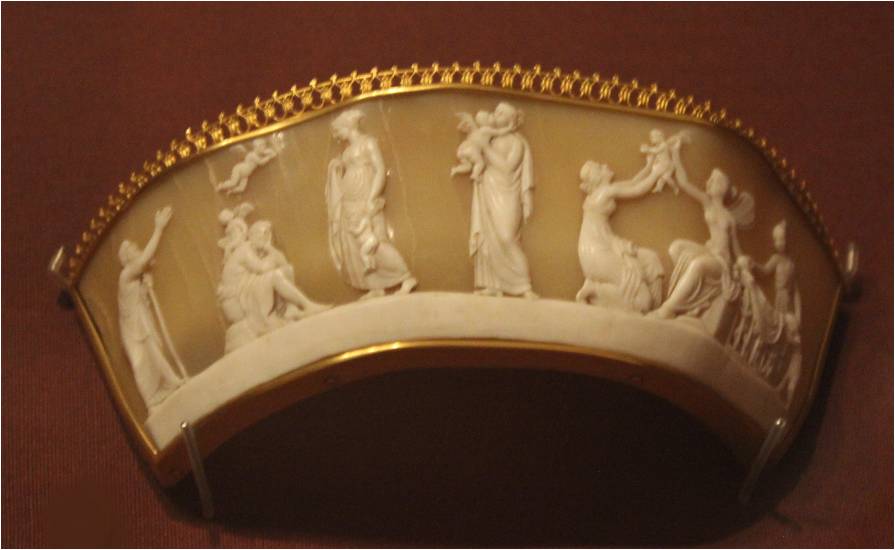
1820ies tiara made of shell and gilt metal. The motif is based on an marble relief called ‘Ages of Love’.
Did you know?
Shell was an especially popular material for cameos because it was inexpensive, readily obtainable, and easily carved. Shell cameos were worn informally during the day, while those made from rarer and more expensive gems were donned with formal evening wear.
With the dawn of the industrial age cameos were mass-produced.
Châtelaines
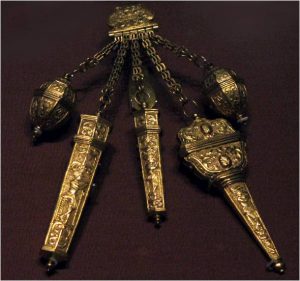 A châtelaine is a set of short chains on a belt worn for carrying keys, thimble, scissors, household seals, vinaigrette, etc. The châtelaine indicated the status of the highest-ranking woman in a household. She was the one who would direct the servants and open or lock the access to the valuables of the house.
A châtelaine is a set of short chains on a belt worn for carrying keys, thimble, scissors, household seals, vinaigrette, etc. The châtelaine indicated the status of the highest-ranking woman in a household. She was the one who would direct the servants and open or lock the access to the valuables of the house.
Did you know?
Younger women and daughters in the house often copied the appearance of high status in a household by wearing decorative châtelaines with a variety of small, beautiful and glittering objects instead of keys.
Slippers
The French Revolution had an impact on shoe fashion. As people began to reject obvious signs of wealth, high heels, large buckles, and patterned silk shoes fell out-off favour. Plain, flat-soled slippers made of thin kid or cloth and with either pointed or rounded toes became fashionable. Slippers were often dyed to match a gown or gloves.
Did you know?
Slippers first became fashionable for women, but by 1800 men wore black slippers to formal events as well.
Fans
Fans were among the most important accessories. Continue here to read my post about the history of fans in England. Click here to see a variety of fans of the Regency period.
Related posts:
- The world of fashion in the 18th century – Part 1: Accessories for Gentlemen
- The Evolution of the Waistcoat in the 18th Century
- The Unrivalled Beauty of the Hand-held Fan in the Romantic Age
- Fashion Meets Scientific Progress: The “Spy Fan”
- Fabulous Fashion Item: A Brief History of the Hand-held Fan
- A Brief History of the Napoleonic Wars told … in 10 Hand-held Fans
Sources
V & A Museum, Cromwell Rd, London SW7 2RL, UK
http://www.victoriana.com/Regency-Era/
http://www.fashionencyclopedia.com/fashion_costume_culture/European-Culture-18th-Century/
http://vintagefashionguild.org/fashion-history/the-history-of-womens-hats/
Article by Anna M. Thane, author of the novel
“Von tadellosem Ruf” (http://amzn.to/2TXvrez)
